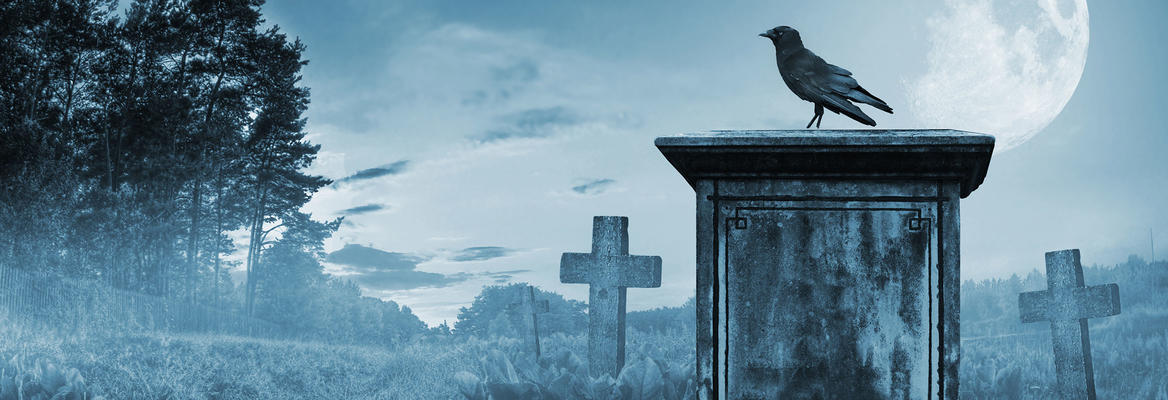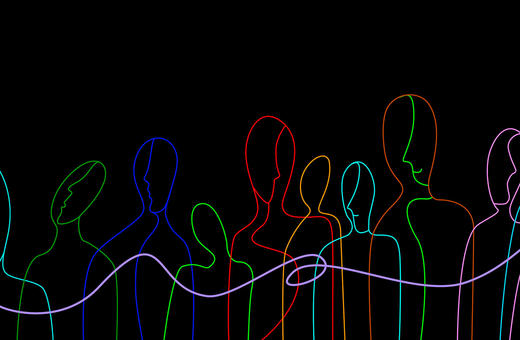In 1832, five months before an Asiatic cholera pandemic reached the United States, Edgar Allan Poe started publishing magazine tales. That summer, the disease killed 3,700 people in Baltimore, where Poe was living, and in two early tales, “Shadow” and “King Pest,” he projected that crisis onto remote, Old World settings. Not until 1842, however, did he fully capture its horror in “The Masque of the Red Death.” Set in Europe, the tale depicts an arrogant ruler’s response to contagion. After his realm has been “half depopulated,” Prince Prospero belatedly invites a thousand “hale and light-hearted friends” to a Gothic abbey and then bolts shut the gates. Five or six months into the quarantine, “while the pestilence raged most furiously abroad,” Prospero defiantly stages a masked ball. But the soirée ends badly. Poe concludes: “Darkness and Decay and the Red Death held illimitable dominion over all.” He implies that while we may temporarily escape a certain kind of death, we cannot avoid dying.
For many, the most frightening aspect of the coronavirus pandemic has been the collapse of our illusions of personal safety. COVID-19 has created shocking scenes, and its complexities have confounded medical experts. Both highly contagious and extremely fatal, the virus and its multiple, dire symptoms have been as puzzling as its insidious transmission by asymptomatic carriers. Factoring in underlying health issues, researchers still cannot explain why some cases remain mild while others spiral from slight discomfort to respiratory failure.
The social upheaval seems equally unreal. In the United States, armed protesters—incited by the President—are rejecting surgical masks and mitigation strategies. They demand the “freedom” to restart the economy, whatever the consequences. Understandably, many wish to return to work. We also long to resume old pastimes—like sporting events—by which (as Kierkegaard remarked) we tranquillize ourselves with the trivial.
Poe was — with the possible exception of Kierkegaard himself — the most deeply preoccupied with mortality, existential dread, and its spiritual corollary, despair.
Prospero’s masked ball, inspired by raging pestilence, illustrates this truth about our species: most people most of the time strive to deny an implacable fact—their own mortality. As Ernest Becker observes in The Denial of Death (1973), “The final terror of self-consciousness is the knowledge of one’s own death, which is the peculiar sentence on man alone in the animal kingdom. This is the meaning of the Garden of Eden myth and the rediscovery of modern psychology: that death is man’s peculiar and greatest anxiety”. Yet as Becker also notes, most human pursuits, especially our most cherished achievements, represent symbolic denial.
“The Masque of the Red Death” exemplifies Poe’s powerful yet perverse attraction for contemporary readers. The perverseness lies in his intractable fascination with death. For among his nineteenth-century contemporaries, Poe was—with the possible exception of Kierkegaard himself—the most deeply preoccupied with mortality, existential dread, and its spiritual corollary, despair. To say that Poe and Kierkegaard were both alive to death is to recognize how they explored, in different forms and registers, the linked problems of fear and denial already afflicting nominally Christian bourgeois culture. Poe devoted his fiction to the subject he embraced (in a preface to his first book) as his legitimate field of study: terror. He traced that terror to the soul and regarded it as a sickness unto death. Fittingly, Kierkegaard’s great work by that title appeared in 1849, the year Poe died.
I have linked these pioneers of dread to bolster the audacious claim made by Michael Capuzzo in Smithsonian magazine: that Poe is “the most influential American author ever.” Yes, more influential than Twain, Whitman, Faulkner, or Morrison. In that article from January 2019, evidence of Poe’s influence comes mostly from popular culture: the Vincent Price Poe films, Poe’s face on the Sgt. Pepper album cover, Homer Simpson’s madcap recitation of “The Raven,” and so forth. But Poe has inspired such ardent, extensive homage, I would argue, because his strange works open us vicariously to the death-anxiety we usually repress. His tales deliver measured doses of the dread that paradoxically makes us feel more fully alive.
One of Poe’s most distinctive themes, premature burial, helps to explain his morbid appeal. Although Becker assumed that fear of death dated from time immemorial, the French historian Philippe Ariès has constructed a more nuanced view. In The Hour of Our Death (1981), he traces the evolution of death imagery and funerary practices across the ages to contrast “the great modern fear of death” with an older attitude of solemn acceptance. The pivotal change occurs in the eighteenth century. Until then, Ariès writes, “incredible as it may seem, human beings as we are able to perceive them in the pages of history have never really known the fear of death”. Previously, people felt sorrow, expressed grief calmly, and acknowledged death’s inevitability. But meek acceptance of mortality faded with the advent of science, medical understanding, and enlightened self-consciousness. By the 1700s, Ariès says, “dissection had become a fashionable art”, and wealthy folk were devising wills to protect their remains from eager anatomists. Some also feared being buried alive and directed that their bodies be preserved until the onset of decay.
As physician Jan Bondeson documents in Buried Alive (2002), scientific debate about the uncertainty of signs of death, a problem elaborated by Jean-Jacques Bruhier in 1749, fueled a reform movement aimed at preventing premature burial. Across Europe, progressive thinkers pondered cases of apparent death and advocated “waiting mortuaries” for the recently deceased. Such topics excited anxieties about death not previously apparent, and analogous literary imaginings produced the cult of melancholy, the Gothic novel, and graveyard poetry. Suffice it to say that these complex cultural influences came down to Poe, a half-century later, via Thomas Gray, Ann Radcliffe, and others. By the nineteenth century, as Bondeson notes, living entombment was stirring new controversy, now inspiring “security coffins” equipped with escape mechanisms. This context illuminates Poe’s “The Premature Burial” (1844), a tale that epitomizes “the great modern fear of death.” Poe used the theme repeatedly to amplify death anxiety by describing the sensations of burial.
While Kierkegaard contemplated death, even suicide, to free himself from the inauthenticity that masked despair, preparing his soul for a leap of faith, Poe projected his anxieties into tales rife with agnosticism.
In Poe’s day, melancholy also had a resurgence in the cult of mourning. Dread disguised itself as sentimentalism and promoted what Ariès has called “the age of the beautiful death”. Meanwhile, accumulating scientific knowledge was challenging religious wisdom. Hard geological evidence undermined the creation story in Genesis as well as the biblical reckoning of time and history. As Kierkegaard remarked sardonically in the preface to Fear and Trembling (1843), everyone was suddenly doubting everything. But while Kierkegaard contemplated death, even suicide, to free himself from the inauthenticity that masked despair, preparing his soul for a leap of faith, Poe projected his anxieties into tales rife with agnosticism. His doubt formed a veritable abyss, and fear of death—with utter uncertainty about a spiritual afterlife—lay at the heart of it all.
Poe had chronic, personal fears—the death of a beloved woman, madness, perverse self-destruction, and accidental burial. With his contemporaries, he also shared several social terrors. Poe was horrified, for example, by Jacksonian mobs and rioting gangs. As a Virginian, he feared slave rebellion, especially after the Nat Turner revolt of 1831. And, having experienced mass death in 1832, when so many acquaintances died of cholera, Poe feared contagion.
But the author’s deepest terror arose from unfocused fear, dread. That unease also permeated a seemingly confident, jingoistic American nation. An increasingly secular culture looked to the mass media, newspapers and magazines, for beliefs and opinions, quoting not preachers but pundits. If, as Benedict Anderson has suggested, print capitalism began to conjure “imagined communities,” reading publics linked by collective national longings, it also began to cultivate audiences attracted by lurid news. Poe’s “The Murders in the Rue Morgue” illustrates the impact of newspapers on public hysteria after a double homicide. The author brilliantly anticipated the “culture of fear” identified by sociologist Frank Furedi in the late twentieth century. In fiction, Poe prefigured many dangers that preoccupy our electronic mass media: frightening strangers (“The Man of the Crowd”), cold-blooded killers (“The Tell-Tale Heart”), sadistic cruelties (“The Pit and the Pendulum”), terrorist acts (“Hop-Frog”), uncontrollable pandemics (“Masque”), and planetary catastrophes (“The Conversation of Eiros and Charmion”).
Poe could not make Kierkegaard’s leap and wrote most brilliantly when sounding the depths of modern doubt.
In an age Ariès associates with “invisible death” and rampant denial, fearful themes resonate powerfully. In How Fear Works (2018) Furedi laments our preoccupation with “therapeutic” socialization and risk avoidance. Long ago we jettisoned the old beliefs that provided a “grammar of meaning” for anxiety. In the process, Furedi writes, fear “lost much of its moral bearing.… The fear of God was increasingly displaced by an unfocused and confusing and therefore often meaningless force: the fear of fear itself”. This is precisely Roderick Usher’s predicament in Poe’s greatest tale, “The Fall of the House of Usher,” where an atmosphere of dread underscores the absence of faith or hope. only “evil things in robes of sorrow” pervade Usher’s domain. Poe’s most celebrated poem, “The Raven,” similarly stages the torment of a man wracked by grief and skepticism. The speaker asks his feathered visitor whether there is “balm in Gilead” (salvation) or whether he will be reunited with Lenore in “some distant Aidenn” (heaven)—already anticipating the bird’s crushing reply, “Nevermore.” Sometimes, however, Poe betrayed a craving for faith, and in works such as “Mesmeric Revelation” he envisioned a transcendent order of being. He even composed a quasi-scientific treatise, Eureka (1848), to prove God’s existence. But he could not make Kierkegaard’s leap and wrote most brilliantly when sounding the depths of modern doubt.
A bit like Furedi, who decries the “fatalistic influence” of our “culture of fear”, Poe also understood, however, that dread can paralyze us. He wrote survival tales (such as “A Descent into the Maelström”) in which characters escape destruction by resisting panic. His final tale of contagion, “The Sphinx,” unfolds during a cholera outbreak in New York. Distressed by daily news, the narrator swoons when a “monster” appears outside his window. But in fact the near-sighted fellow has been gazing at a death’s-head moth dangling before his eyes. Yes, perspective matters, facts matter. So do logic and reason. Like Poe’s narrator, we can inflate trifling risks into terrible threats. Just as ignorantly, though, we can dismiss deadly pandemics as trumped-up hoaxes, becoming, alas, the most recent victims of Prospero’s arrogance.







